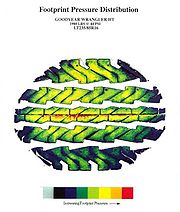
Contact patch
Encyclopedia

Tire
A tire or tyre is a ring-shaped covering that fits around a wheel rim to protect it and enable better vehicle performance by providing a flexible cushion that absorbs shock while keeping the wheel in close contact with the ground...
that is in actual contact with the road surface. It is most commonly used in the discussion of pneumatic tires, (i.e. pressurized tires), where the term is strictly used to describe the portion of the tire’s tread that touches the road surface. The term “footprint” is used almost synonymously.
The following discussion only applies to pneumatic tires.
Contact patch size
The contact patch is the only connection between the road and the vehicle. The size and shape of the contact patch as well as the pressure distribution within the contact patch are important to the ride qualities and handling characteristics of a vehicle. Since the wear characteristics of tires is a highly competitive area between tire manufacturers, a lot of the research done concerning the contact patch is considered highly proprietary and, therefore, very little is published on the subject.Because pneumatic tires are flexible, the contact patch is different when the vehicle is in motion from when it is static. Because it is so much easier to make observations of the contact patch without the tire in motion, it is more common to conduct studies of the static contact patch.
Statically, the size, shape, and pressure distribution are functions of many things, the most important of which are the load on the tire and the inflation pressure:
- The larger the load on the tire, the larger the contact patch.
- The larger the inflation pressure, the smaller the contact patch.
Unfortunately, these two properties are not linearly proportional to the area of the contact. Put another way, a 10% change in load or inflation pressure usually does not result in a 10% change in the contact patch. This makes intuitive sense, because while you can alter the load or pressure freely, the contact patch size will always be limited by the tire geometry.
See also
- Camber thrustCamber thrustCamber thrust and camber force are terms used to describe the force generated perpendicular to the direction of travel of a rolling tire due to its camber angle and finite contact patch...
- Cornering forceCornering forceCornering force or side force is the lateral force produced by a vehicle tire during cornering.Cornering force is generated by tire slip and is proportional to slip angle at low slip angles. The rate at which cornering force builds up is described by relaxation length...
- Frictional contact mechanicsFrictional contact mechanicsContact mechanics is the study of the deformation of solids that touch each other at one or more points. This can be divided into compressive and adhesive forces in the direction perpendicular to the interface, and frictional forces in the tangential direction...
- Ground pressureGround pressureGround pressure is the pressure exerted on the ground by the tires or tracks of a motorized vehicle, and is one measure of its potential mobility, especially over soft ground. Ground pressure is measured in pascals which corresponds to the EES unit of pounds per square inch...
- Pneumatic trailPneumatic trailPneumatic trail or trail of the tire is a trail-like effect generated by compliant tires rolling on a hard surface and subject to side loads, as in a turn...
- Slip (vehicle dynamics)Slip (vehicle dynamics)In vehicle dynamics, slip is the relative motion between a tire and the road surface it is moving on. This slip can be generated either by the tire's rotational speed being greater or less than the free-rolling speed , or by the tire's plane of rotation being at an angle to its direction of...

